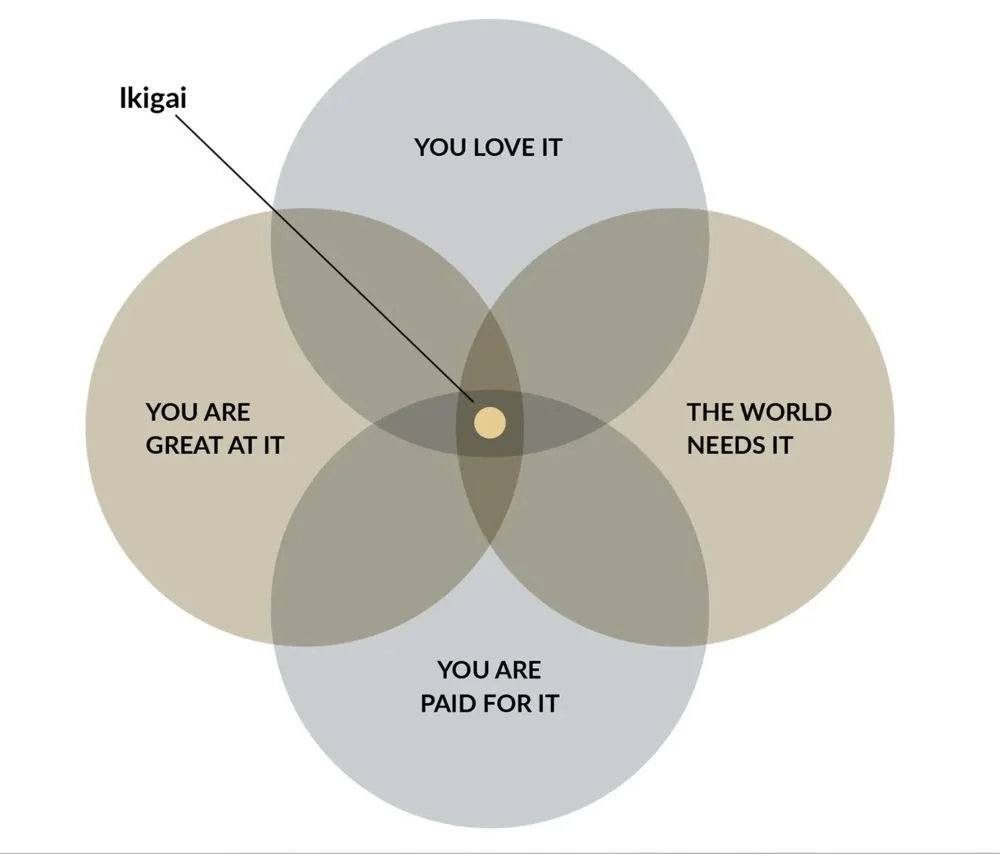Ikigai: The Sweet Spot of Fulfillment
This past summer, Jewel wrote about kintsugi—the Japanese art of mending pottery. In this short post, we’ll riff on another Japanese concept—Ikigai.
I was introduced to the concept of Ikigai by my friend Matt Ludmer, the founder of the Aligned Center, which has hosted several events I’ve facilitated, including my course on Cultural Intelligence in 2020. Matt, since meeting him seven years ago, has been a trusted and loyal friend. Not only do I deeply respect his decades-long exploration of Tibetan Buddhism, non-dual Judaism, and Integral metatheory; after a very successful career as a wealth manager on Wall Street for 30 years, he is now working to expand the very concept of wealth beyond the financial into the many dimensions that make our lives worth living. In his upcoming work, True Wealth: The 7 Dimensions of Aligned Living, Matt outlines wealth of wholeness, interiority, development, healing, and more.
So, if Ikagai is a framework Matt thought I should check out, I knew to take his advice seriously.
The image above, which displays a basic representation of Ikigai, made sense to me right away, particularly since it has taken me so long to reach the sweet spot in the middle. As fulfilled as I have been for several decades in my creative pursuits, and as a life-partner and father, truth be told, it’s only in my fifties that my passions and skills and talents have aligned with my professional life and the needs of the world (as I perceive it.) But had I been aware of a life philosophy such as Ikigai earlier, who knows?
Which is why I’m sharing it with you, the readers of our leadership blog.
From the Ikigai Living site, here is a basic explanation of the meaning of Ikigai, which has been part of Japanese culture for several hundred years:
Defining Ikigai
“In its literal form, the term ‘iki’ refers to the concept of life or being alive, while ‘kai,’ (pronounced as ‘gai’ in this case) can be translated as worthiness, fruitfulness, or effectiveness.
It is worth noting that ‘kai’ carries a strong connotation of challenge. Associated with passion, it implies that pursuing it requires a significant amount of effort and determination. Thus, a literal translation may not fully convey the depth and significance of the term. As a result, numerous translations have been proposed, all of which are considered to be accurate:
reason to live
the purpose of life
reason for being
the meaning of life
reason to get up in the morning or jump out of bed
what makes life worth living
the thing that you live for
happiness of being
a raison d’etre”
The sweet spot in the middle of the diagram is an ideal and worthy aspiration. But what happens if there isn’t an alignment? The following, more detailed version of Ikigai provides answers.
Take some time to contemplate the image. How close are you, as a leader, to the sweet spot? What can you adjust to move closer to it? Do any of the four descriptions extending from the dots nearest the Ikigai sweet spot apply to you?
Finding Your Ikigai
According to the Positive Psychology website, additional questions can be asked and answered to help you identify your Ikigai:
Do what you love:
What did you enjoy doing as a child or in your early adult years?
What do you do now in your spare time that makes you happy?Do what you are good at:
Do you know your strengths and skills? What are they?
What do people ask you to help them with?Do something the world needs:
What difference do you want to make in the world? What causes and values do you hold close to your heart? Is there something you wish to change about how the world operates?Do something you can be paid for:
What service or product could you sell (what would people pay you for)?
What job could you do?
A purpose-driven framework such as Ikigai isn’t only for career development; it can apply to other areas of our lives, just as wealth can be defined in more than one dimension. Imagine if young people in high school were introduced to this concept as a map of discovery and exploration, and urged to track their own answers to the questions directly above, through early adulthood and beyond.
Hopefully, such young people would find their sweet spot before their fifties.


